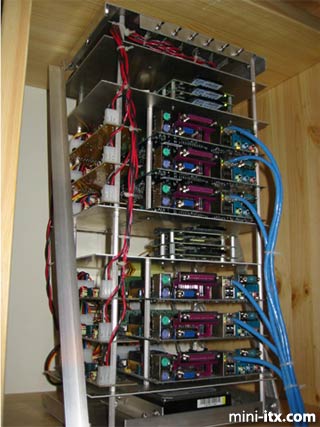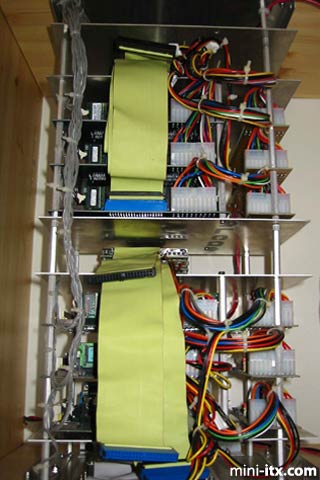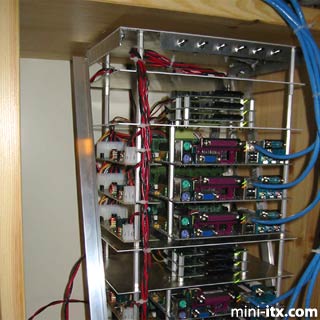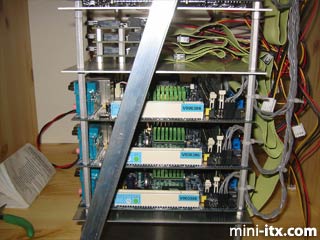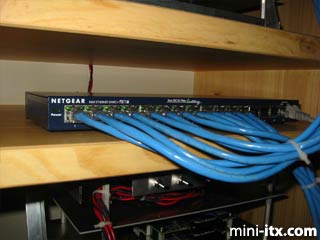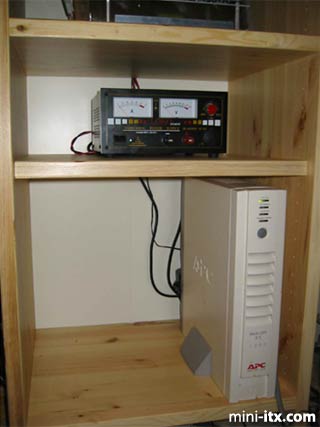Posted on February 25, 2004
|
The top rack houses nodes one through six (node one is the controlling node). The bottom plate of the top rack also houses the 160 GB ATA-133 hard disk drive used by the controlling node. All other nodes make use of the IBM microdrives. Node number three has a spare compact flash adapter which can be used to duplicate microdrives for easy node maintenance.
|
The disk drive and power cabling to the motherboards was dressed as was sanely possible on the back panel. The liberal use of nylon cable ties helps reduce the tendency of pc cabling to develop into a rats-nest.
|
The bottom rack houses nodes seven through 12, with one microdrive for each node mounted in an identical manner to the top rack. Other than lacking a hard drive on the bottom plate, the second rack is identical to the first. All the metalwork is fabricated by hand using 0.0625 inch aluminum plate and 3/4 inch aluminum angle stock. All of the standoffs and metal bits are attached using stainless steel 4-40 machine screws and aircraft style locknuts. Stick-on rubber feet keep the bottom plate from marring delicate surfaces.
There was no cutting or bending involved. All metal bits were simply cut, drilled, and bolted together using 4-40 hardware.
All wiring is crimped by hand using standard crimp connectors and tools available from a popular online electronics components supplier. The hand made wiring harnesses are dressed by twisting the wires to assure low noise, and then fixing the wiring in place using nylon cable ties. The power/reset switches are on-off-on center off , three position momentary contact toggle switches available from most good electronics supply stores.
|
The wiring for these switches is hand soldered at the switch end, and standard 0.1 inch header connectors were crimped at the motherboard end to make the necessary connections.
Networking
|
There is nothing sacred about the networking. I used the internal fast ethernet adapters which came with my mini-itx boards. The network switch was a low cost 16 port fast ethernet switch purchased at an office supply store for about $80. The cabling was crimped by hand using good quality four twisted pair (8 conductor) cat 5 cable.
Power Considerations
|
The DC-DC converters require a clean, well-regulated 12VDC source. I chose to use a heavy duty 60 ampere 12VDC switching power supply capable of delivering 60 amperes peak current which I ordered from an online electronics test equipment supplier. Since badly conditioned AC power is potentially damaging to expensive computing equipment, I use a 1 KVA UPS purchased at an office supply store to make sure the cluster can't be "bumped off" by power line glitches and droputs.
 |
 |
 |
Quick Links
Mailing Lists:
Mini-ITX Store
Projects:
Show Random
Accordion-ITX
Aircraft Carrier
Ambulator 1
AMD Case
Ammo Box
Ammo Tux
AmmoLAN
amPC
Animal SNES
Atari 800 ITX
Attache Server
Aunt Hagar's Mini-ITX
Bantam PC
BBC ITX B
Bender PC
Biscuit Tin PC
Blue Plate
BlueBox
BMW PC
Borg Appliance
Briefcase PC
Bubbacomp
C1541 Disk Drive
C64 @ 933MHz
CardboardCube
CAUV 2008
CBM ITX-64
Coelacanth-PC
Cool Cube
Deco Box
Devilcat
DOS Head Unit
Dreamcast PC
E.T.PC
Eden VAX
EdenStation IPX
Encyclomedia
Falcon-ITX
Florian
Frame
FS-RouterSwitch
G4 Cube PC
GasCan PC
Gingerbread
Gramaphone-ITX-HD
GTA-PC
Guitar PC
Guitar Workstation
Gumball PC
Hirschmann
HTPC
HTPC2
Humidor 64
Humidor CL
Humidor II
Humidor M
Humidor PC
Humidor V
I.C.E. Unit
i64XBOX
i-EPIA
iGrill
ITX Helmet
ITX TV
ITX-Laptop
Jeannie
Jukebox ITX
KiSA 444
K'nex ITX
Leela PC
Lego 0933 PC
Legobox
Log Cabin PC
Lunchbox PC
Mac-ITX
Manga Doll
Mantle Radio
Mediabox
Mega-ITX
Micro TV
Mini Falcon
Mini Mesh Box
Mini-Cluster
Mobile-BlackBox
Moo Cow Moo
Mr OMNI
NAS4Free
NESPC
OpenELEC
Osh Kosh
Pet ITX
Pictureframe PC
Playstation 2 PC
Playstation PC
Project NFF
PSU PC
Quiet Cubid
R2D2PC
Racing The Light
RadioSphere
Restomod TV
Robotica 2003
Rundfunker
SaturnPC
S-CUBE
SEGA-ITX
SpaceCase
SpacePanel
Spartan Bluebird
Spider Case
Supra-Server
Teddybear
Telefunken 2003
TERA-ITX
The Clock
ToAsTOr
Tortoise Beetle
Tux Server
Underwood No.5
Waffle Iron PC
Windows XP Box
Wraith SE/30
XBMC-ION

